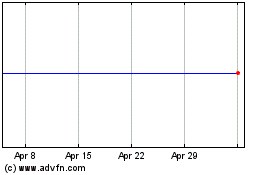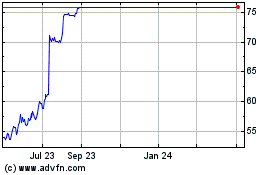Black Knight’s Mortgage Monitor: Most Borrowers Impacted by Hurricane Harvey Have Significant Equity; 350,000 in Hurricane...
October 02 2017 - 9:00AM

Today, the Data & Analytics division of Black Knight, Inc.
(NYSE:BKI) released its latest Mortgage Monitor Report, based on
data as of the end of August 2017. On the heels of reporting an
early, 16 percent spike in mortgage delinquencies in Hurricane
Harvey-related disaster areas, Black Knight examined the equity
outlook for mortgage holders impacted by either Hurricane Harvey or
Hurricane Irma. As Black Knight Data & Analytics Executive Vice
President Ben Graboske explained, despite the extent of the damage
in Texas, Hurricane Harvey-impacted borrowers have a greater equity
stake, which may bode well for long-term recovery.
“Before Hurricane Harvey made landfall, the average combined
loan-to-value ratio (CLTV) for homeowners with mortgages in what
became FEMA-designated disaster areas was 53 percent,” said
Graboske. “Right on par with the national average, that’s the
lowest we’ve seen since prior to 2004. This equates to
approximately $131,000 in equity per borrower. That works out to a
lot of skin in the game, and will likely serve as strong motivation
for borrowers not to walk away from a storm-damaged home. In
addition, over 75 percent of mortgages in the Hurricane Harvey
footprint are held in Fannie Mae, Freddie Mac or Ginnie Mae
securities. Therefore, the bulk of borrowers affected by the storm
will be able to find assistance under the various foreclosure
moratoriums and forbearance programs that have been instituted.
While we have already seen an early spike in delinquencies in
Hurricane Harvey-impacted disaster areas, with many more likely to
follow in September’s data, the combination of available assistance
and healthy equity stakes on the part of borrowers are both very
positive signs for the long term.
“In Florida, Hurricane Irma impacted a much larger portion of
the state. The 48 FEMA-declared Hurricane Irma disaster areas
include over 90 percent of the state’s mortgaged properties. To put
this in perspective, that means that by balance, over five percent
of all mortgages in the U.S. are included in Hurricane Irma’s
disaster areas. Unlike Houston, though, where all-time-high home
prices have contributed to a significant reduction in negative
equity, home prices in Florida remain 17 percent below their 2006
peak. On average, borrowers in Hurricane Irma-related disaster
areas have a CLTV of 57 percent, somewhat higher than the national
average. Of the 3.2 million borrowers impacted by Irma, an
estimated 170,000 were still in negative equity positions before
the storm, with another 180,000 having less than 10 percent equity
in their homes. Due to lackluster home price recovery since the
housing crisis, the negative equity rate in Irma’s disaster area is
nearly twice the national average.”
Between the two hurricanes, 4.4 million borrowers representing
$705 billion in unpaid principal balance (UPB) were affected. By
volume, the GSEs and Ginnie Mae have the most exposure (3.2 million
loans, $466 billion in UPB), but in terms of share of total
portfolio exposed, private-label securities (PLS) are most
impacted. Nearly one out of every 10 loans remaining in a PLS was
impacted by one or the other of the storms. Not only are 8.3
percent of all of outstanding PLS loans connected to properties
within Hurricane Irma-related disaster areas, but over 17 percent
of those same borrowers remain in a negative equity position with
an additional eight percent having less than 10 percent equity. All
in, as many as one in four PLS loans in Hurricane Irma’s path had
limited equity available, prior to any potential home price impact
due to storm damage.
| As was
reported in Black Knight’s most recent First Look news release,
other key results include: |
| Total U.S. loan
delinquency rate: |
|
3.93% |
| Month-over-month change
in delinquency rate: |
|
0.72% |
| Total U.S. foreclosure
pre-sale inventory rate: |
|
0.76% |
| Month-over-month change
in foreclosure pre-sale inventory rate: |
|
-3.27% |
| States with highest
percentage of non-current* loans: |
|
MS, LA, AL, WV, ME |
| States with lowest
percentage of non-current* loans: |
|
MT, OR, MN, ND, CO |
| States with highest
percentage of seriously delinquent** loans: |
|
MS, LA, AL, AR, TN |
*Non-current totals combine foreclosures and delinquencies as a
percent of active loans in that state. **Seriously delinquent loans
are those past-due 90 days or more.Totals are extrapolated based on
Black Knight’s loan-level database of mortgage assets.
About the Mortgage Monitor The Data &
Analytics division of Black Knight manages the nation's leading
repository of loan-level residential mortgage data and performance
information on the majority of the overall market, including tens
of millions of loans across the spectrum of credit products and
more than 160 million historical records. The company's research
experts carefully analyze this data to produce a summary
supplemented by dozens of charts and graphs that reflect trend and
point-in-time observations for the monthly Mortgage Monitor Report.
To review the full report, visit:
http://www.BKFS.com/CorporateInformation/NewsRoom/Pages/Mortgage-Monitor.aspx
About Black KnightBlack Knight
is a leading provider of integrated software, data and analytics
solutions that facilitate and automate many of the business
processes across the homeownership lifecycle.
Black Knight is committed to being a premier business
partner that clients rely on to achieve their strategic goals,
realize greater success and better serve their customers by
delivering best-in-class software, services and insights with a
relentless commitment to excellence, innovation, integrity and
leadership. For more information on Black Knight, please visit
http://www.blackknightinc.com/.
For more information:
Michelle Kersch 904.854.5043michelle.kersch@bkfs.com
Mitch Cohen646.926.7741mitch@mprg.com
Black Knight (NYSE:BKI)
Historical Stock Chart
From Mar 2024 to Apr 2024

Black Knight (NYSE:BKI)
Historical Stock Chart
From Apr 2023 to Apr 2024
